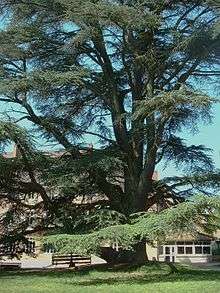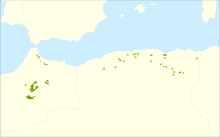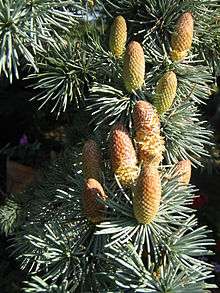Cedrus atlantica
Cedrus atlantica, the Atlas cedar, is a species of tree in the pine family Pinaceae, native to the Atlas Mountains of Morocco (Middle Atlas, High Atlas), to the Rif, and to the Tell Atlas in Algeria.[2] A majority of the modern sources[3][4][5][6][7][8][9][10] treat it as a distinct species Cedrus atlantica, but some sources[11][12] consider it a subspecies of Lebanon cedar (C. libani subsp. atlantica).
| Cedrus atlantica | |
|---|---|
 | |
| Atlas cedar (Ifrane, Morocco) | |
| Scientific classification | |
| Kingdom: | Plantae |
| Clade: | Tracheophytes |
| Division: | Pinophyta |
| Class: | Pinopsida |
| Order: | Pinales |
| Family: | Pinaceae |
| Genus: | Cedrus |
| Species: | C. atlantica |
| Binomial name | |
| Cedrus atlantica | |
 | |
| Distribution map | |
| Synonyms | |
|
C. libani subsp. atlantica (Endl.) Batt. & Trab. | |
Description


Fully grown, Atlas cedar is a large coniferous evergreen tree, 30–35 m (rarely 40 m) tall, with a trunk diameter of 1.5–2 m. It is very similar in all characters to the other varieties of Lebanon cedar; differences are hard to discern. The mean cone size tends to be somewhat smaller (although recorded to 12 cm,[2] only rarely over 9 cm long, compared to up to 10 cm in C. brevifolia, and 12 cm in C. libani, though with considerable overlap (all can be as short as 6 cm). The Cedrus atlantica leaf length (10–25 mm) is similar that of C. libani subsp. stenocoma, on average longer than C. brevifolia and shorter than C. libani subsp. libani, but again with considerable overlap.[2][8][13]
Ecology
Atlas cedar forms forests on mountainsides at 1,370 to 2,200 m, often in pure forests, or mixed with Algerian fir - Abies numidica, Juniperus oxycedrus, holm oak - Quercus ilex, and Acer opalus. These forests can provide habitat for the endangered Barbary macaque (Macaca sylvanus), a primate that had a prehistorically much wider distribution in northern Morocco and Algeria.[14]
Currently, Morocco has the highest total surface of Atlas cedar in the world, and it forms vast forests in the humid zones of the country, around the Middle-Atlas range, the oriental and Northern High-Atlas range, and in the Western and Central Rif mountain range. The current total area is around 163,000 hectares, of which around 115,000 hectares (80%) are situated in the Middle-Atlas mountains. The species is in danger of human use, wood harvesting and fires. Data that go back to 1927 show higher number of Atlas cedars (more than 150,000 hectares) in the Middle-Atlas mountains only. The Rif mountains had one of the largest cedar forests in the past, but forests nowadays are much smaller, 15% of the total cedar forests in Morocco. Recently massive reforestation campaigns have taken place in the region of Ifrane Province.
In Algeria, the Atlas cedar has been in massive decline. According to data from 1966 the species inhabited 23,000 hectares, forming forests around the Djurdjura Mountains in Kabylie and Aures Mountains. However, it is expected that it currently inhabits fewer than 15,000 hectares owing to extensive fires and human use.
Cultivation and uses

Landscape
C. atlantica is common in cultivation as an ornamental tree in temperate climates. In garden settings, often the glaucous forms are planted as ornamental trees, distinguished as the Glauca group, a cultivar group. Also, fastigiate, pendulous, and golden-leaf forms are in cultivation. The Atlas cedar is useful in cultivation because it is more tolerant of dry and hot conditions than most conifers.
Many of the cultivated trees have glaucous (bluish) foliage, more downy shoots, and can have more leaves in each whorl; young trees in cultivation often have more ascending branches than many cultivated C. atlantica specimens.[15]
In the UK the following cultivars have gained the Royal Horticultural Society's Award of Garden Merit (confirmed 2017):[16]
An Atlas cedar is planted at the White House South Lawn in Washington, DC. President Carter ordered a tree house built within the cedar for his daughter Amy. The wooden structure was designed by the President himself, and is self-supporting so as not to cause damage to the tree.[20]
Forestry
Cedar plantations, mainly with C. atlantica, have been established in southern France for timber production.
References
- Thomas, P. 2013. Cedrus atlantica. In: IUCN 2013. IUCN Red List of Threatened Species. Version 2013.1. <www.iucnredlist.org>. Downloaded on 13 July 2013.
- Gaussen, H. (1964). Genre Cedrus. Les Formes Actuelles. Trav. Lab. For. Toulouse T2 V1 11: 295-320
- Gymnosperm database Cedrus.
- GRIN Taxonomy for Plants Cedrus Archived 2009-01-20 at the Wayback Machine.
- NCBI Taxonomy Browser Cedrus.
- Flora of China vol. 4
- Qiao, C.-Y., Jin-Hua Ran, Yan Li and Xiao-Quan Wang (2007): Phylogeny and Biogeography of Cedrus (Pinaceae) Inferred from Sequences of Seven Paternal Chloroplast and Maternal Mitochondrial DNA Regions. Annals of Botany 100(3):573-580. Available online
- Farjon, A. (1990). Pinaceae. Drawings and Descriptions of the Genera. Koeltz Scientific Books ISBN 3-87429-298-3.
- Farjon, A. (2008). A Natural History of Conifers. Timber Press ISBN 0-88192-869-0.
- Christou, K. A. (1991). The genetic and taxonomic status of Cyprus cedar, Cedrus brevifolia (Hook.) Henry. Mediterranean Agronomic Institute of Chania, Greece.
- Güner, A., Özhatay, N., Ekim, T., & Başer, K. H. C. (ed.). 2000. Flora of Turkey and the East Aegean Islands 11 (Supplement 2): 5–6. Edinburgh University Press. ISBN 0-7486-1409-5
- Eckenwalder, J. E. (2009). Conifers of the World: The Complete Reference. Timber Press ISBN 0-88192-974-3.
- Schwarz, O. (1944). Anatolica. Feddes Repertorium 54: 26-34.
- C. Michael Hogan. 2008. Barbary Macaque: Macaca sylvanus, GlobalTwitcher.com, ed. N. Stromberg Archived August 31, 2009, at the Wayback Machine
- Walters, W. M. (1986). European Garden Flora Vol 1. ISBN 0-521-24859-0.
- "AGM Plants - Ornamental" (PDF). Royal Horticultural Society. July 2017. p. 16. Retrieved 24 January 2018.
- "RHS Plantfinder - Cedrus atlantica 'Aurea'". Royal Horticultural Society. Retrieved 21 January 2018.
- "RHS Plantfinder - Cedrus atlantica (Glauca Group) 'Glauca'". Royal Horticultural Society. Retrieved 21 January 2018.
- "RHS Plantfinder - Cedrus atlantica (Glauca Group) 'Glauca Pendula'". Royal Horticultural Society. Retrieved 21 January 2018.
- "Archived copy". Archived from the original on 2009-05-02. Retrieved 2009-04-15.CS1 maint: archived copy as title (link)
External links
| Wikimedia Commons has media related to Cedrus libani subsp. atlantica. |
